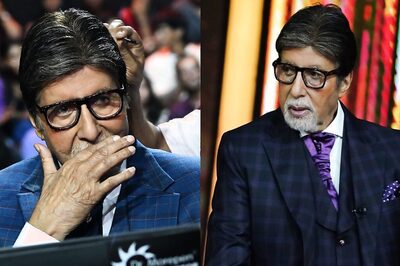
views
Shane Keith Warne was born on 13th September 1969 and at the time of his retirement in January 2007 was the highest wicket taker in Tests. He made his Test debut against India in 1991-92 at Sydney and had a pretty ordinary debut taking just 1 wicket and conceding 150 runs in his 45 overs. At that time even the most gifted fortune teller would not have been able to look into his crystal ball and predict the bright future and the glittering career that Warne would have. Since the late 1970s and throughout the 1980s, the dominance by the West Indies with their accent on pace bowling meant that the spin bowling cupboards in world cricket were bare and that spin bowling, particularly leg-spin bowling was in danger of getting extinct. Even though Warne made a pretty unspectacular beginning to his Test career, he rose from strength to strength and by the time of his retirement was unarguably the greatest leg-spinner of all-time.
As of 20th January 2019, he had played the joint maximum number of Tests by an out and out bowler with James Anderson and 12 more than the next spinner in Muttiah Muralitharan. At the time of his retirement, he had played in 145 Tests and taken 708 wickets at a bowling average of 25.41 and a bowling strike rate of 57.4. He was also handy with the bat and scored 3154 runs at a batting average of 17.32 with 12 fifties in Tests. There have been 21 spin bowlers who have taken a minimum of 200 Test wickets and Warne has the 3rd best bowling average after Muralitharan and Clarrie Grimmett. His bowling strike rate was the 5th best of the 21 spinners in this elite list.
Warne also has the 2nd most 5 wicket hauls in an innings and the 2nd most 10 wicket hauls in a match in Tests after Muralitharan. There are some bowlers who have spectacular records and are prolific wicket-takers against certain countries or in certain regions across the world. However, apart from a poor record against India, Warne had a bowling average lesser than 30 against all Test playing nations. He played 14 Tests against India and took 43 wickets at an unflattering average of 47.18. This was mainly due to the fact that Indian batsmen are generally considered the world’s best players of spin and in that in 2 out of the 3 tours that Warne travelled to India he was not fully fit and injury free. However, in his last tour of India in 2004, Warne played a crucial role in keeping one end tight, enabling Australia to win a Test series on Indian soil after 35 years. In his first 2 Test series in India in 1998 and 2001 he had bowling averages in excess of 50 but in 2004 he took 14 wickets at 30.07 and played a vital role in Australia’s series victory.
Even after his unflattering start against India, the powers that be in Australian cricket had faith in Warne and he vindicated their faith by taking 3 wickets in the 4th innings against Sri Lanka at the SSC ground in Colombo when the visitors were defending a meagre target of 181. This gave him a much-needed fillip at the highest level but he still did not feel that he had nailed down his berth in the Australian team. During the 2nd Test against West Indies at Melbourne in December 1992, Warne came to the party and took 7/52 when Australia were defending 359 in the 4th innings. This showed that he belonged at the top level and from then on, he became a permanent fixture in the Australian playing XI in Tests. In the Ashes series that followed in 1993 he took 34 wickets in the 6 Test series. By the time he retired he had taken 195 wickets against England which is a record for the most wickets taken by a bowler against any opposition in Tests.
Warne came on in leaps and bounds and played his 64th Test against South Africa at Adelaide on 30th January 1998. At the conclusion of this Test, he had taken 303 wickets at a bowling average of 23.81, with a wicket every 62 balls. Until this period, by his own admission he did not really understand the art of setting up a batsman but merely relied on ripping his leg-break as prodigiously as he could. In 1998, he suffered a near career threatening shoulder injury and became a different and cannier bowler after that. In his next 81 Tests he took 405 wickets at 26.61 with a wicket after 54 balls. After that Test against South Africa at Adelaide, he endured a horrible tour of India and spent some time out of the game due to his shoulder injury.
During the 1993 Ashes, Warne’s first delivery of the series, to Mike Gatting was an absolute peach. It pitched a mile outside Gatting’s leg stump and spun viciously to hit Gatting’s off stump. The ball was famously known as ‘The ball of the century.’ Warne made one of the biggest blunders of his career by coming back from injury before he was fully fit and he had an average tour of the Caribbean in 1999. He was below par and took just 2 wickets in the firstt 3 Tests at a horrendous average of 134. For the first 3 Tests, both Stuart MacGill and Warne were included in the playing XI. However, Warne’s poor form caused him to be dropped from the playing XI for the 4th Test and that caused a major thaw in his relationship with his captain Steve Waugh. In the calendar year 2005, Warne took 96 wickets in 15 Tests, which is a record for the most wickets taken by a bowler in a calendar year in Tests. However, Warne couldn’t prevent England beating Australia 2-1 in the 5 Test series and he decided to carry on for one more crack at the old enemy in 2006-07. In the 2006-07, Australia decimated England 5-0 and the last Test at the Sydney Cricket Ground turned out Warne’s swansong in Test cricket. He took 23 wickets in 5 Tests in his farewell Test series.
Even though Warne is known primarily for his exploits in Tests, he has turned quite a few matches Australia’s way from hopeless situations even in ODIs. In the 1996 World Cup semi-final against West Indies at Mohali, Warne rescued Australia from a perilous situation by taking 3 quick wickets to derail West Indies’ chase of 208. Australia won by 5 runs and Warne had weaved his magic yet again. In the 1999 ODI World Cup semi-final against South Africa at Edgbaston, Australia were in trouble having posted a below par total of 213. In reply, South Africa were coasting at 48 for no loss when Steve Waugh threw the ball in desperation to Warne. Warne responded with a fiercely spun leg break to dismiss Herschelle Gibbs and in the next over did the same to dismiss Gary Kirsten. He broke the back of South Africa’s chase and the the match ended in a tie with Warne taking 4/29. Australia progressed to the final on the basis of finishing ahead of the Proteas at the Super Six stage. Warne replicated the feat in the final against Pakistan, taking 4/33 as Australia won the World Cup for the 2nd time. Warne won the Man of the Match in both the semi-final and the final and showed that his poor form in the last year was just a temporary blip in his career graph. While Warne’s record in ODIs pales in comparison to his exploits in Tests, there is no doubt that he was a match-winner in ODIs also.
While no one can doubt Warne’s phenomenal prowess as a cricketer, he has been embroiled in a lot of controversies in his career that tarnished his reputation off the field and even led to him not being made captain of Australia. One of Warne’s most notorious misjudgments was accepting money from an Indian bookmaker referred to as ‘John’ in Sri Lanka in 1994. John gave Warne USD 5000 and then sought from him information about team selection and pitch and weather conditions which Warne provided. Warne was wrong and greedy to take the bookmaker’s money, which was supposedly offered without strings while he was playing in an ODI tournament in Colombo. What further exacerbated the situation was the cover-up by the Australian Cricket Board. Warne also showed his hypocritical side by accusing Pakistan’s captain Salim Malik of attempting to bribe him to deliberately underperform. To accuse a fellow player of such a grave sin is usually frowned upon in sports and when the matter of Warne’s accepting money from John came to the fore in 1998, he led to a huge backlash in the cricketing fraternity. Warne was later vindicated when Malik was handed a life ban by the Pakistan Cricket Board in 2000.
On 10th February 2003, on the eve of Australia’s opening World Cup match, a drug test he had undergone before the finals of a triangular ODI series in Australia had turned up positive. Warne had tested positive for a diuretic. Diuretics were on the list of banned substances for sportsmen because of their capacity to act as a masking agent for steroids. Warne denied taking performance enhancing drugs. He stated that he had merely taken a single tablet, which he believed a fluid reduction tablet and said that he was unaware that it was a prohibited substance. He said the reason for taking the tablet was to look good on television for the announcement of his retirement from ODIs. A 3-person tribunal was set up to investigate the veracity of Warne’s statement. According to the guidelines established by the World’s Anti-Doping Agency, Warne ought to have received a 2-year ban from all forms of cricket. However, he was already 33 years of age and the tribunal felt that a 2-year ban might result Warne’s premature retirement. Therefore, he was merely suspended for a year when he ought to have received a much harsher punishment for his transgression.
Just prior to the 1999 World Cup he was fined by the ICC and given a 2-match suspended ban for his remarks about Arjuna Ranatunga saying that he didn’t like Ranatunga and that he was not in a club of one. In 2013, Warne was fined USD 4500 and banned for one match for using obscene language and making inappropriate contact with Marlon Samuels and showing serious dissent with an umpire’s decision during a BBL game in 2013. Throughout his cricketing career, Warne had been guilty of sending lewd and sexually explicit text messages to a number of women.
The bookie scandal and the variety of off-field scandals are what led to the Australian Cricket Board overlooking him as the man to captain Australia. This was a shame because he seemed to have a flair for the job and many ex Australian players regarded him as having a shrewd cricketing brain. There is no doubt that his off-field shenanigans led to him not receiving the ultimate honour in Tests.
Some of the plaudits to come Warne’s way include him being named one of Wisden’s Cricketers of the Year in the 1994 Wisden Cricketers’ Almanack. He was named Wisden’s Leading Cricketer of the year 2004, in the Wisden Cricketers’ Almanack in 2005. In 2000, he was selected by a panel of cricket experts as one of the 5 Wisden Cricketer’s of the century. He was the only active cricketer to be chosen for the award and the only bowler in that list.
In 2007, Cricket Australia and Sri Lanka Cricket decided to name the trophy for which future Test series between Australia and Sri Lanka would vie for, as the Warne-Muralitharan Trophy in recognition of the achievements of these two stalwarts.
In a nutshell we can conclude that even though Warne’s life of the field was far from perfect, he is definitely one of the greatest leg-spinners and all-time great bowlers ever to play the game and that he came along at the right time to revitalize and reinvigorate the fading art of leg-spin bowling.
Read all minute-by-minute news updates for Uttar Pradesh election results 2022, Punjab election results 2022, Uttarakhand election results 2022, Manipur election results 2022, and Goa election results 2022.
Click here for seat-wise LIVE result updates.


















Comments
0 comment